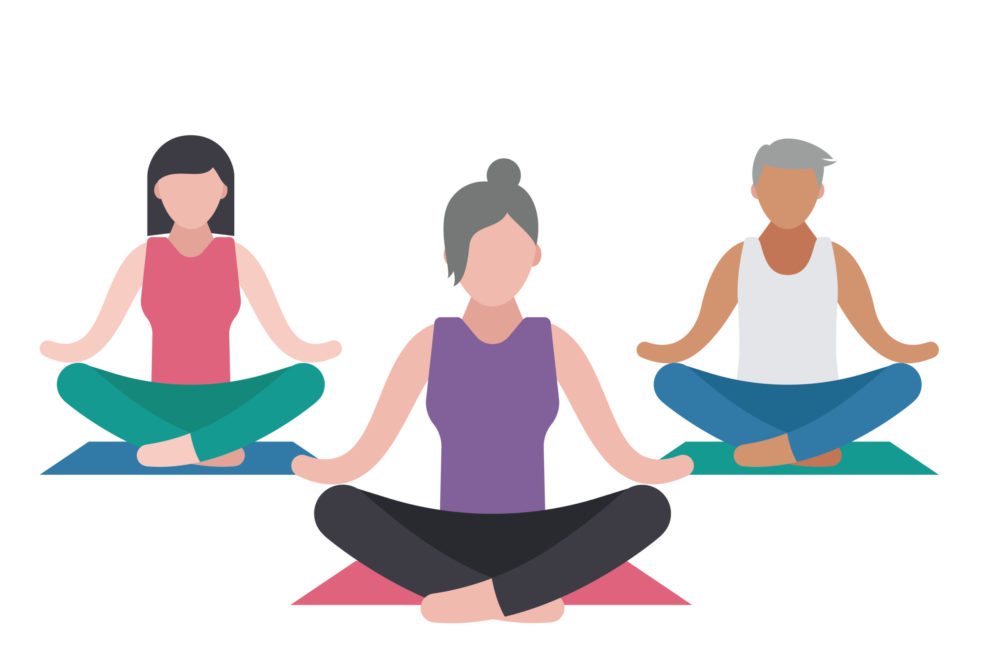
Meditation- for Seniors, for Everyone
By Larry Dawalt, Hospice & Palliative Care Charlotte Region
What do you see when you mentally picture a meditator? Do you see a guru-like person sitting cross-legged on a mat? Or a hippie left over from Woodstock? Or do you see your neighbor next door sitting silently still on the back porch early in the morning- like my neighbors do?
Yes, I am a meditator- and even though I have not yet been officially acknowledged by the federal government, according to my grocery store every Thursday and most restaurants that give discounts, I am also a senior. While I had come across the topic of mediation more than once over the years in my spiritual studies, it wasn’t until 2012 that I began to practice in earnest. Although most spiritual paths integrate some form of mindfulness and meditation, meditation actually goes beyond formal religious practice, which is certainly good news for the 20% of Americans who identify themselves as ‘spiritual but not religious.’
From the perspective of scientific research, meditation has been shown to improve immune function, decrease inflammation, increase positive emotions, decrease anxiety, improve self-control, decrease feelings of loneliness, and stimulate creative thinking. Specifically, for seniors, meditation has been shown to slow down the development of dementia-related diseases, aid in digestion, help in the development of a sharp mind, enhance pleasant moods, improve memory, and promote calmness and relaxation. All of these impressive benefits don’t happen immediately, but some of them do and that makes it worth investigating and trying.
One of the biggest benefits for me has been improved focus and attention, as well as an increase in my ability to concentrate. This has been especially important in my end of life care work as a spiritual care provider and grief counselor. When I am with someone in a helping role, I want to be fully present in body, mind and spirit. At Hospice & Palliative Care Charlotte Region, we call this ‘compassionate concentration’- the ability to stop multitasking and ‘one task’ on the needs and concerns of the person/s for whom we are caring. Meditation plays a vital role in this because it teaches us to slow our minds down and focus on the here and now.
A famous meditation teacher once said, “If you want to understand your mind, sit down and observe it.” But how? How do you do it? Or at least how do you get started?
There are many wonderful books and audio instructions for those who want to learn and delve and deeper, but I want to give you some basics to help you get started.
First, find a quiet, secluded place where you won’t be interrupted. You can sit in a traditional meditation position on a cushion, or you can sit in a chair. I started in a chair and still meditate that way at times. You’ll want to be wearing loose, comfortable clothing and no shoes if possible so you can relax your feet.
Set an amount of time for your session. I recommend five minutes to start. Use your phone or a timing device of some sort to measure the duration of the session. If you have a smart phone, I highly recommend the app ‘Insight Timer.’ Make it your intention and try your hardest to not physically move until the session is over.
Once the starting bell has sounded, simply breathe. Feel the air coming in and out of your body. Feel it through your nose, feel it expand your chest and abdomen, and feel it exiting. Be natural. Just let it come and go, over and over. When you hear sounds, listen to them arising- and then hear them as they disappear. When meditating outside, I hear birds, cars, airplanes, the wind, dogs barking and other natural sounds of the morning. The sounds come and the sounds go. They are temporary.
Thoughts are the same way- they come and go, too. The goal is to let them arise, linger for a moment, then pass away just like a sound comes and goes, so you can get back to the breath and back to being fully present in the here and now. That is contrary to the way we usually function because we typically go from one thought to the next, to the next, to the next, and eventually come to the realization that we don’t remember what we were thinking about in the first place. We get lost in space- or at least in head space. Meditation invites us to simply acknowledge our thoughts and begin again- back to the breath, back to the present moment, back to the here and now.
Before you know it, five minutes will have passed and you will find that you are one step closer to having more control over what goes on inside your head. Then, during the course of your day, you’ll find yourself putting aside random thoughts and staying with your task at hand. You’ll find yourself calmer and more relaxed, sharply focused and fully present; and you will also discover that you can do this anytime you need to rejuvenate, or just clear your head.
Start with five minutes and see what happens. You may want to form a small group, or if you live in a community, you may want to set aside a time to meditate together or have a teacher come and take you beyond the basics. Regardless of how, I hope you will try meditation. It could eventually work wonders.



